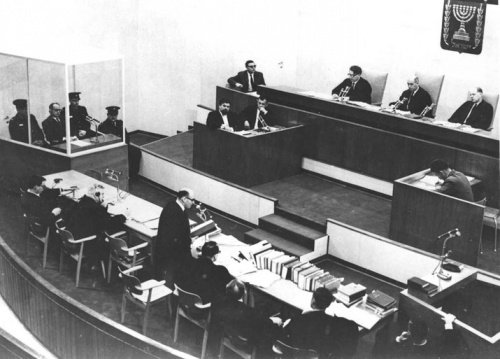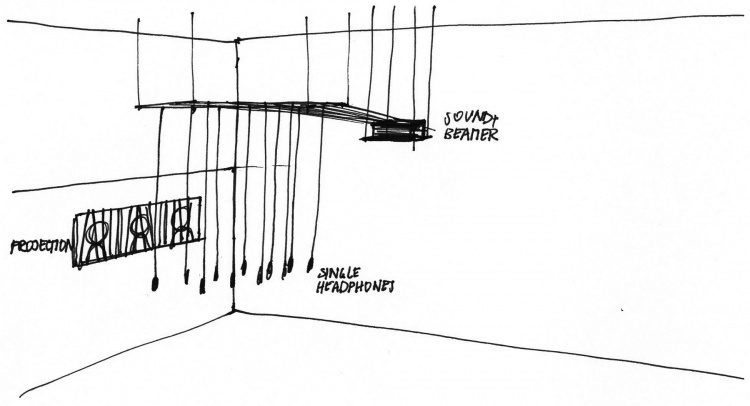User:Natasa Siencnik/project3: Difference between revisions
| Line 72: | Line 72: | ||
<br /> | <br /> | ||
//// | |||
=====<i>This project was brought to you by the GLICKMAN REAL ESTATE CORPORATION.</i>===== | =====<i>This project was brought to you by the GLICKMAN REAL ESTATE CORPORATION.</i>===== | ||
Revision as of 15:22, 19 June 2011
The Man in the Glass Box (1961–2011)
A TRIAL ABOUT THE BANALITY OF EVIL

Court room with Eichmann in the glass booth, 1961
Concept
50 years after the Eichmann trial in Israel took place, the full compendium of more than 400 hours of film footage documenting the trial were released earlier this year on Youtube. In 1961, former SS officer and highest figure in the Nazi hierarchy responsible for facilitating the extermination of European Jewry, was charged and tried with committing crimes against the Jewish people and humanity. The case of multiple controversies was the first telecast of actual courtroom proceedings and was from the beginning conceptualized as a symbolic performance with a special stage design which placed the accused in a bullet-proof glass booth, a film director that made deliberate cinematographic decisions and an international audience that witnessed the trial from the living room. Originally shown as daily newsreels on international television, the trial was performed as a morality play, not surprisingly ending with the death sentence of the accused, which until today remains the only civil execution ever carried out in Israel.
In the installation "The Man in the Glass Box (1961–2011)", the aesthetic and narrative strategies of the trial are made transparent. The proceedings are performed as an audio and video drama in three acts: the appeal, the testimony, and the verdict. From the ceiling 6 headphones are hanging, all sliced in half, of which each presents a disembodied voice of one persona in the proceedings: the accused, the judge, the prosecutor, the defender, a witness, and a political journalist. All voices contribute to the trial from their own perspective, however, only disclose a fraction of the story.
The audio is expanded by a three channel video projection, which likewise disassembles the original film footage. As a result of the required simultaneous translations of the original proceedings from Hebrew (and partly German) into English, French and German, a large part of the footage is showing the silent protagonists of the trial, while a translator – mostly a female voice – is talking for all of them as a voice-over. The artist reenacts the trial by recreating the silent film scenes of the footage all by herself and is lending her voice to the translator who presents all characters of the play. Thus she is renarrating the story for the visitors, who can combine the stories, change perspectives and play an active role in the perception of the trial and politics of remembrance.
Characters
The Accused (Eichmann)
The Judge
The Prosecutor
The Defender
A Witness
A Political Journalist
Installation

Installation set-up with beamer and headphones
PART #1 : Audio
Here comes the link to the audio recording.
PART #2 : Projection
Here comes the link for the three channel video.
Project Progress
Key Words
Leiden mit Leidenschaftlosigkeit versprachlichen
Bilerverbot – kein Bild vom Grauen möglich
Unüberschaubarkeit des Materials
Paradoxon des Zeugens
Creation of Memory
Collective Heardbeat
Erinnerung abspielen
Verfremdungseffekt
Video Samples
Dismissed Ideas
Repeatingly reading the testimony of Aveva Fleischmann and running until I can't go on
Same story repeats / doubles / tripples until it gets diffuse and incomprehensible
One voice for all protagonists of the trial (protocolls) > translations > who's speaking? > a story of millions
Telephone (children's play) / Stille Post > memories get difuse, change of certain details
Video gets interrupted by real-estate commercials (like original in 1961)
Image ban > empty (white) tv screens as space for imagination
Nested loops (story within a story) Natasa / Norma Rose / Hanna Arendt / Aveva Fleischmann
////



